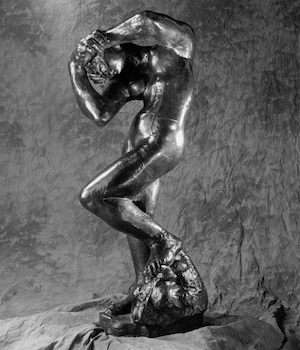Weisman Museum to Present Rodin and Women: Muses, Sirens, Lovers
 The Frederick R. Weisman Museum of Art will present Rodin and Women: Muses, Sirens, Lovers—Selections from the Iris and B. Gerald Cantor
Collections from Saturday, January 18, until Sunday, March 29. A special opening reception will
be held on Sunday, January 19, from 3 to 5 PM. Admission is free and the general public
is invited to attend. The display is the final exhibition curated by Weisman Museum
director Michael Zakian, who passed away on January 14, 2020.
The Frederick R. Weisman Museum of Art will present Rodin and Women: Muses, Sirens, Lovers—Selections from the Iris and B. Gerald Cantor
Collections from Saturday, January 18, until Sunday, March 29. A special opening reception will
be held on Sunday, January 19, from 3 to 5 PM. Admission is free and the general public
is invited to attend. The display is the final exhibition curated by Weisman Museum
director Michael Zakian, who passed away on January 14, 2020.
Auguste Rodin (1840–1917) is considered to be the greatest sculptor since Michelangelo. At the peak of his career, he was the most famous sculptor in the Western world. Rodin and Women: Muses, Sirens, Lovers explores one of the artist’s key passions. The exhibition will feature approximately 40 bronzes, depicting women as models, companions, classical and religious ideals, and sources of artistic inspiration. Included are some of his most famous works, such as The Kiss, Eve, and Venus.
“It is especially rewarding to bring Rodin back to the Weisman Museum of Art,” said Michael Zakian, director of the Weisman Museum. “In 2001 we hosted Rodin’s Obsession: The Gates of Hell which looked at how a major commission inspired many of his most popular pieces, such as The Thinker. This exhibition, on the theme of women, allows us to examine another aspect of his life and work—his fascination with the female form.”
This exhibition explores his complex relationships with the women in his life and women's roles in shaping the grand ideals of Western culture. A muse is someone who provides creative inspiration. A siren is a beautiful and seductive female—often a temptress who may lead men astray. Lover refers to the many women who shared Rodin’s life, offering affection, companionship, and support. For Rodin, these roles were often shifting and interchangeable.
Rodin broke with the art of his time by seeing the human body as a vehicle for intense emotion. Rejecting 19th-century academic traditions of perfect, idealized form, he made sculpture with rough, coarse surfaces that convey physical vitality. Using rigorous modeling and anatomical distortions, he was able to capture his immediate, instinctive reactions to his models.
“Rodin believed that art should above all tell the truth, and his truth was rooted in what he called nature and in the contemporary world he saw about him,” said Judith Sobol, guest curator of the exhibition and Curator of Collections and Exhibitions of the Iris and B. Gerald Cantor Foundation. “In telling this truth, Rodin revolutionized sculpture and brought it out of its past of centuries-old conventions into what today we know as modern art.”
The Artist
Born in 1840 into a modest French family, Rodin was rejected by the official French academy of art but received traditional instruction at a minor government school for craft and design. For nearly a decade he earned his living as an anonymous member of a large, commercial sculpture workshop. A turning point occurred in 1875 when he visited Italy to study the work of Michelangelo. He returned to Paris and began producing powerfully expressive figures that altered the course of his career. In 1880, when he was 40 years old, Rodin received his first public commission for a monumental set of bronze doors on the theme of The Gates of Hell. By 1890 his growing success allowed him to have a large workshop of assistants, which enabled him to increase his creative production. By the time of his death in 1917, he was celebrated around the world.
Exhibition Credits
Rodin and Women: Muses, Sirens, Lovers has been organized and made possible by the Iris and B. Gerald Cantor Foundation and was curated by Judith Sobol, the foundation’s curator of collections and exhibitions. Zakian designed and organized the installation at the Weisman Museum.